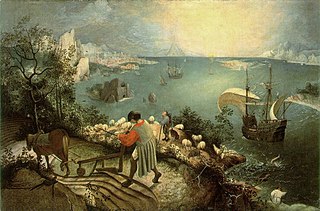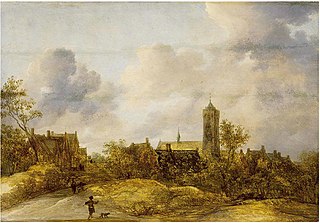
In Greek mythology, Icarus was the son of the master craftsman Daedalus, the architect of the labyrinth of Crete. After Theseus, king of Athens and enemy of Minos, escaped from the labyrinth, King Minos suspected that Icarus and Daedalus had revealed the labyrinth's secrets and imprisoned them—either in a large tower overlooking the ocean or in the labyrinth itself, depending upon the account. Icarus and Daedalus escaped using wings Daedalus constructed from birds’ molted feathers, threads from blankets, the leather straps from their sandals, and beeswax. Before escaping, Daedalus warned Icarus not to fly too low or the water would soak the feathers and not to fly too close to the sun or the heat would melt the wax. Icarus ignored Daedalus's instructions not to fly too close to the sun, causing the beeswax in his wings to melt. Icarus fell from the sky, plunged into the sea, and drowned. The myth gave rise to the idiom, "fly too close to the sun." In some versions of the tale, Daedalus and Icarus escape by ship.

"Musée des Beaux Arts" is a 23-line poem written by W. H. Auden in December 1938 while he was staying in Brussels, Belgium, with Christopher Isherwood. It was first published under the title "Palais des beaux arts" in the Spring 1939 issue of New Writing, a modernist magazine edited by John Lehmann. It next appeared in the collected volume of verse Another Time, which was followed four months later by the English edition.

"Landscape with the Fall of Icarus" is an ecphrastic poem by the 20th-century American poet William Carlos Williams that was written in response to Landscape with the Fall of Icarus, traditionally attributed to Pieter Bruegel. Williams first published the poem as part of a sequence in The Hudson Review in 1960, subsequently using the sequence as the basis for his final book, Pictures from Brueghel and Other Poems, published in 1962.

Landscape with the Fall of Icarus is a painting in oil on canvas measuring 73.5 by 112 centimetres now in the Royal Museums of Fine Arts of Belgium in Brussels. It was long thought to be by the leading painter of Dutch and Flemish Renaissance painting, Pieter Bruegel the Elder. However, following technical examinations in 1996 of the painting hanging in the Brussels museum, that attribution is regarded as very doubtful, and the painting, perhaps painted in the 1560s, is now usually seen as a good early copy by an unknown artist of Bruegel's lost original, perhaps from about 1558. According to the museum: "It is doubtful the execution is by Bruegel the Elder, but the composition can be said with certainty to be his", although recent technical research has re-opened the question.

Joos de Momper the Younger or Joost de Momper the Younger was a Flemish landscape painter active in Antwerp between the late 16th century and the early 17th century. Brueghel's influence is clearly evident in many of de Momper's paintings. His work is situated at the transition from late 16th-century Mannerism to the greater realism in landscape painting that developed in the early 17th century. He achieved considerable success during his lifetime.

Frans de Momper was a Flemish landscape painter who, after training in Antwerp, worked for a while in the Dutch Republic. Here he was exposed to the work of Dutch landscape painters such as Jan van Goyen. His later paintings prefigure the imaginative landscapes of Hercules Segers.

Storm at Sea is an oil painting on panel by the Netherlandish Renaissance artist Pieter Bruegel the Elder, painted in c. 1569. It is in the Kunsthistorisches Museum in Vienna.
Landscape with the Fall of Icarus may refer to:

Landscape with Sea and Mountain is an oil-on-canvas painting by Flemish painter Joos de Momper. It was painted in the early 1620s, and is now in the Museum of Prado in Madrid.

Mountainous Landscape with a Bridge and Four Horsemen is an oil painting on panel by the Flemish painter Joos de Momper. Its date of execution is unknown. The painting was once attributed to Paul Bril. It is part of the permanent collection of the Louvre in Paris.

Village at Full Moon is a tempera-on-panel painting by Flemish painter Joos de Momper. It was painted in the early 17th century, possibly in the 1620s, and is now in the National Gallery in Prague.

Tobias' Journey is an oil-on-panel painting by Flemish artist Joos de Momper. The painting showcases Momper's large scale, imaginary landscape painting and his interpretation of perspective in distant views while at the same time treating a biblical subject. The painting depicts the story of Tobit, a righteous Israelite of the tribe of Naphtali, living in Nineveh, who is sent to recover is father's money to Media, escorted by the Archangel Raphael. The painting is currently housed at the Rockox House in Antwerp.

Minerva's Visit to the Muses is an oil-on-oak-panel painting by Flemish painter Joos de Momper. The painting depicts a scene from Ovid's Metamorphoses, which tells of Minerva visiting the muses on Mount Helicon, to listen to their song and see the Hippocrene. In the painting, the scene takes place in a wooded mountain side. At the same time, a pastel, distant landscape is depicted in the background. The painting is currently housed at the Royal Museum of Fine Arts in Antwerp.

Landscape with Grotto is an oil-on-panel painting by Flemish painter Joos de Momper. The painting was completed in the 1610s, possibly in 1616, and is now in the Rheinisches Landesmuseum in Bonn.

Large Mountain Landscape is a large oil-on-canvas painting by Flemish painter Joos de Momper. The painting was completed in the early 17th century. It is currently part of the private collection of the Liechtenstein Museum in Vienna.

Landscape with a Mountain Pass is a large oil-on-canvas painting by Flemish painter Joos de Momper. It was completed sometime between 1600 and 1625. The painting was acquired by Prince Karl Eusebius von Liechtenstein from the art dealer Peter Bousin between 1674 and 1680, and is currently part of the private collection of the Liechtenstein Museum in Vienna.

Mountain Landscape with Castle is an oil-on-panel painting by Flemish painter Joos de Momper. It was probably completed in the 1600s.

Mountain Landscape is a large oil-on-canvas painting by Flemish painter Joos de Momper. The painting was probably completed in the 1620s and is currently housed at the Kunsthistorisches Museum in Vienna.

Alpine Landscape is an oil-on-canvas painting by Flemish painter Tobias Verhaecht. The painting was completed between 1600 and 1615, and is now in the Museum of Prado in Madrid.

Grotto Landscape with a Hermitage, also called The Reading Hermit, is an oil on canvas painting by Flemish painters Jan Brueghel the Younger and Joos de Momper. It was painted around 1625, and is currently in private collection. It depicts a reading hermit in a monumental grotto, several pilgrims and various animals. It was painted in Antwerp.




















